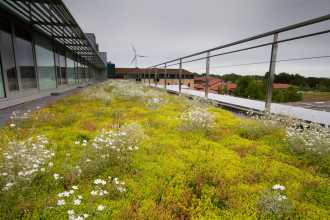Our country pages
Africa
Europe
Search
Order a sample
You can order up to 3 free sample tiles.
We'll aim to deliver your sample order within 5-7 working days from your order date.
Are Blueroofs the answer to storm water run off?

Green Roofs offer the chance to create natural spaces in the sky, improving air quality, biodiversity and well-being for building users. Whether designed to be walked on, provide a roof-top garden, or simply to improve the aesthetic of the building a Green Roof is an increasingly popular choice, especially in busy urban areas.
Blue roofs, by comparison, are designed to hold water on a flat roof without penetrating the membrane. In the past, blue roofing technology had a poor reputation as it allowed water to pool on a roof and remain there, where its weight and volume could spell disaster. However, technology has now improved dramatically and by pairing with green roofing technology, a full stormwater runoff system and sustainable drainage solution can be developed.
Jump to section
Why is stormwater runoff a problem?
As we continue to develop our cities and towns, our green spaces are being replaced with buildings and pavements. So now when it rains, the water (stormwater runoff) runs off roofs and into the street. Not only does this cause unsightly staining to buildings, but runoff picks up oil, pesticides, dirt, and other pollutants as it makes its way through drains and into our streams, rivers and lakes. Polluted runoff is a real threat to clean water.
How it works
Blue Roof systems control water flow from rooftops and limit flooding during heavy rainfall. A water attenuation board, which stores water temporarily, is covered with a permeable top layer. To improve the roof’s attenuation capabilities, a Green Roof system can be created on this permeable top layer. Outlets on the roof work to restrict the flow rate of water to greenfield levels.
Blue Roofs can be deployed in inverted roof structures, podium decks, warm roofs and ballasted roofs. Most commonly an inverted roof build-up is employed which would comprise a waterproofing layer, insulation, water attenuation void former, filter layer and the top, permeable, layer.
Blue Roofs tend to require fewer outlets than a traditional design, which means that construction times can be shorter and there are fewer penetrations which reduce the risks of faults or leaks. The number of flow restrictor outlets, the openings within that outlet and their position must be carefully designed and installed accordingly. An important step in the installation process is a post-installation inspection to ensure that the roof has been built to the intended design. (Note these are types of Green Roof not Blue Roof and would only apply if a green roof is being installed as part of the system.)
When installing a Green Roof solution sedum roofs lend themselves to rainwater attenuation, owing to the succulent nature of the planting; Wildflower and Biodiverse roofs deliver meadow habitats to support a greater breadth of flora and fauna than Sedum types; while Intensive Green Roofs are designed to be trafficked, creating gardens and recreational spaces for sport and leisure.
Reasons to specify a blue roof
BMI Blue Roofs comply fully with the National Federation of Roofing Contractors’ (NFRC) Blue Roof design guidelines. The NFRC guide says that the roof should hold water for no longer than 24 hours and the flow rate should be such that half of the roof’s capacity is discharged after 12 hours. Blue Roofs should be equipped with an emergency overflow outlet to allow excess water to be discharged should there be an unusually high rainfall, that is a 1:100 storm event. In BMI’s system, the overflow is set into the middle of the main outlet, with a vertical pipe cut at a height to match maximum water levels. This alleviates the historic issue with blue roofing whereby water would be held for too long and lead to potential damage.
When researching how to tackle stormwater runoff in urban and built-up areas, blue roofs are the ideal solution. Blue Roofs are gaining popularity in the UK as an alternative form of Sustainable Urban Drainage Systems (SUDS). Other methods such as below-ground water attenuation tanks are almost always more expensive to construct and may simply not be possible in built-up areas. When paired with a green roof system, blue roofs are ideal for dealing with the stormwater runoff problem faced by UK towns and cities.


